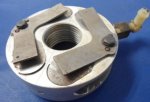pgoodger04
Cadet
- Joined
- Aug 15, 2020
- Messages
- 6
I have a '74 Mercury 650 3 cylinder that I am pulling my hair out on! Sorry this is going to be long but I have tried everything I have thought of as well as scouring the net and service manual for this engine for ideas.
The motor sat for a couple of years before I started using it again.
I started off going through the carbs. Stripped the carbs down to bare bodies ultrasonic cleaned, all new gaskets, needles and seats. All orifices have been shot with carb cleaner and then air shot down each bore. All passages are clear and clean. Checked floats made sure that they both floated and then reset the primary and secondary levers. Then bench tested with fuel and primer bulb. Needles to say the new seats leaked like a sieve. So the Old ones went back in.
I checked the compression.
Cylinder 1 130 PSI
Cylinder 2 130 PSI
Cylinder 3 128 PSI
I put a new carbon button and spring in the distributor and new plug wires and coil pickup wire. New Champion L77V plugs. With the plugs out of the cylinder head and grounded all three plug have a good spark. Putting a steel drift in the end of the plug wire you can get a spark to jump to a ground from 3/8 to 1/2 inch for each plug wire.
The top cylinder is running great, Cylinders 2 and 3 have a miss or are dead. You can remove the plug wires from these 2 cylinders and there is no change in rpm. Every once in a while there will be a surge in rpm indicated on the digital tach
The bottom 2 cylinders the plugs are wet every time I take them out.
I have checked the timing and synchronization of the engine according to the service manual. The power-head will not run well enough to get the timing and synchronization properly set. I have to jack the primary pick up to about 8 to 12 BTDC to get it to even stay running @ arround 1000-1200 rpm in a body of water
Both carbs appear to have the same amount of vacuum coming into the throat of each carb. I dont have a way to accurately test this. It doesn't matter where the idle adjustment is set on the bottom carb nothing seems to work.
I am going to take the floats back out tomorrow and weigh them individually on a gram scale. The bottom carb is getting a small pool of fuel right infront of the main nozzle.
I am thinking the smoking gun is the bottom carb float level is high and I am flooding the bottom 2 cylinders or is there something else that I need to be looking at that I have missed?
Any help would be greatly appreciated.
The motor sat for a couple of years before I started using it again.
I started off going through the carbs. Stripped the carbs down to bare bodies ultrasonic cleaned, all new gaskets, needles and seats. All orifices have been shot with carb cleaner and then air shot down each bore. All passages are clear and clean. Checked floats made sure that they both floated and then reset the primary and secondary levers. Then bench tested with fuel and primer bulb. Needles to say the new seats leaked like a sieve. So the Old ones went back in.
I checked the compression.
Cylinder 1 130 PSI
Cylinder 2 130 PSI
Cylinder 3 128 PSI
I put a new carbon button and spring in the distributor and new plug wires and coil pickup wire. New Champion L77V plugs. With the plugs out of the cylinder head and grounded all three plug have a good spark. Putting a steel drift in the end of the plug wire you can get a spark to jump to a ground from 3/8 to 1/2 inch for each plug wire.
The top cylinder is running great, Cylinders 2 and 3 have a miss or are dead. You can remove the plug wires from these 2 cylinders and there is no change in rpm. Every once in a while there will be a surge in rpm indicated on the digital tach
The bottom 2 cylinders the plugs are wet every time I take them out.
I have checked the timing and synchronization of the engine according to the service manual. The power-head will not run well enough to get the timing and synchronization properly set. I have to jack the primary pick up to about 8 to 12 BTDC to get it to even stay running @ arround 1000-1200 rpm in a body of water
Both carbs appear to have the same amount of vacuum coming into the throat of each carb. I dont have a way to accurately test this. It doesn't matter where the idle adjustment is set on the bottom carb nothing seems to work.
I am going to take the floats back out tomorrow and weigh them individually on a gram scale. The bottom carb is getting a small pool of fuel right infront of the main nozzle.
I am thinking the smoking gun is the bottom carb float level is high and I am flooding the bottom 2 cylinders or is there something else that I need to be looking at that I have missed?
Any help would be greatly appreciated.




















